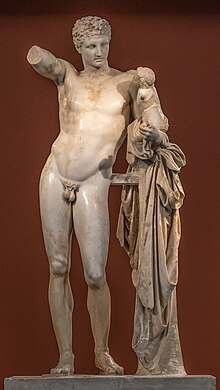


A statue is a free-standing sculpture in which the realistic, full-length figures of persons or animals are carved or cast in a durable material such as wood, metal or stone. Typical statues are life-sized or close to life-size. A sculpture that represents persons or animals in full figure, but that is small enough to lift and carry is a statuette or figurine, whilst those that are more than twice life-size are regarded as a colossal statues.[1]
Statues have been produced in many cultures from prehistory to the present; the oldest-known statue dating to about 30,000 years ago. Statues represent many different people and animals, real and mythical. Many statues are placed in public places as public art. The world's tallest statue, Statue of Unity, is 182 metres (597 ft) tall and is located near the Narmada dam in Gujarat, India.
- ^ Collins online dictionary: Colossal "2. (in figure sculpture) approximately twice life-size."; entry in the Getty Art & Architecture Thesaurus® Online